Kentucky Pest News Newsletter
HIGHLIGHTS IN THIS ISSUE
Number 1020__________May 10, 2004
TOBACCO
CORN
WHEAT
FOREST
SHADE TREES AND ORNAMENTALS
HOUSEHOLD
DIAGNOSTIC LAB HIGHLIGHTS
IPM TRAP COUNTS
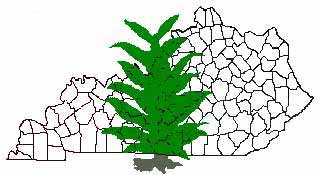
TOBACCO
BLACKLEG/BACTERIAL SOFT ROT ACTIVE IN TRANSPLANT SYSTEMS
By William Nesmith
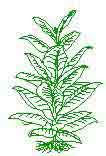 Bacterial soft rot and blackleg are active in some
greenhouses transplant production systems. A slimy to
jelly-like soft rot (accompanied with strong odors) was
common on the base of stems, but in some cases was
advancing up one side of the stem after going systemic in
what is the blackleg phase of the disease. With the warmer
outside temperatures, activity is also likely in outdoor float
systems too, but it is not likely in outdoor ground beds
until later when more growth and canopy closure have
developed. In ground beds these soft rots occur mainly in
the transplants during wet periods when the plants are
about ready to be set and growers cannot get them into the
field.
Bacterial soft rot and blackleg are active in some
greenhouses transplant production systems. A slimy to
jelly-like soft rot (accompanied with strong odors) was
common on the base of stems, but in some cases was
advancing up one side of the stem after going systemic in
what is the blackleg phase of the disease. With the warmer
outside temperatures, activity is also likely in outdoor float
systems too, but it is not likely in outdoor ground beds
until later when more growth and canopy closure have
developed. In ground beds these soft rots occur mainly in
the transplants during wet periods when the plants are
about ready to be set and growers cannot get them into the
field.
The bacteria causing these diseases need very wet
conditions and are wound invaders, so reducing
wounding is a key to control, especially during prolonged
wet events. The bacteria produce enzymes that are able to
degrade primary cell walls (pectin) but not those with
secondary developments (cellulose and hemicellulose).
Consequently, fertilization regimes that favor rapid
growth and slow maturity keep a higher percentage of the
cells in a susceptible stage. Also, related to this, the
symptoms will vary with the age of tissues. The tender
leaves and succulent stems may rot extensively when
young and growing fast, but as these tissues become
somewhat hardened the rot becomes limited and may
spread up one side of the stem, resulting in splitting of the
stem.
Historically with traditional plant beds, this was a major
disease when trying to hold plants for several days after
they had been pulled. The disease started as a soft rot of
the leaves that had touched the ground followed by spread
into the soft tender stems. That soil connection is not as
involved in float plants, as it was outdoors, but is still
important. Now, inoculum is often introduced from
outside the bed on mowers but once established on/in a
plant the microbe flows down the stem and onto the soil
surface where it rots weak leaves (weak due to canopy
shade) in contact with the wet soil. A few years ago, I
encountered a very serious case where grass/weed
clippings had been discharged into the float beds while
mowing around the bed-site with tractor-mounted
equipment. It was too wet to do anything else, the grower
said - missing the point of where the clippings landed! A
few days later, while still wet, the tobacco plants were
clipped - the epidemic that followed within 48 hours of
clipping destroyed 80% of the plants. The story time-line
went something like this: Inoculum was introduced while
the plants were wet; microbes became established on the
plants during wet periods, just waiting for a wound to
enter; wounding of the plants occurred while they were
wet during a hard clipping giving the pathogen an entry
site; the succulent plants provided many young cells that
could be successfully attacked by the microbe; and the
grower was left to either not set a crop or get new plants
from off his farm.
During discussion with agents reporting recent outbreaks,
all cases involved plants that had been recently clipped
and were overly succulent, especially where growers had
"pushed" some plants trying to catch an early transplant
season. In other seasons, we have seen major outbreaks
occur in situations where growers report "hard clipping" -
removing much more tissue than normal.
Blackleg is also common some years in the field shortly
after transplanting, especially during rainy seasons in
fields set with plants that have either been `pushed' with
nitrogen, clipped hard, or pulled while wet and stored
before transplanting. It is very important not to confuse
this phase of the disease with black shank - the two
diseases at this stage can only be distinguished in a lab.
Maintain good air circulation on plants being held for
transplanting into the field on wagons, etc.
Cultural controls are the keys to limiting this disease, not
chemicals. Use cultural practices designed to grow the
plant slowly enough that tissues mature rapidly, by
reducing wounding, and by keeping the system dry. To
minimize the development of blackleg in floats consider
the following: Do not over-fertilize; Do not mow plants
while they are wet; disinfect the mower between beds, and
the blade often (at minimum between beds); do not allow
leaf debris to drop into the trays during clipping of plants
or from mowing outside the system; and keep the soil
surface as dry as possible.
No chemical is highly effective in controlling this disease,
especially under strong disease pressure when plants are
highly susceptible due to growing rapidly, wounds, and
wetness. Streptomycin is labeled for plant bed use and
improves control of soft rots, too, when used as a
preventive for angular leaf spots. However, in our studies
of rescue situations (where the disease is already active in
the beds), streptomycin applications have improved
control compared to no application, but seldom is the
effect appreciable unless also accompanied by major
changes in cultural practices to reduce plant susceptibility.
Moreover, streptomycin is not specifically labeled for use
in the greenhouse on any crop, nor does the label
specifically prohibit its use in greenhouse or float beds.
Streptomycin is labeled for use in outdoor plant beds,
only. Greenhouse and float bed use is not on the label,
however, these sites are not specifically prohibited on the
label. Therefore, growers may elect to use streptomycin in
these systems, but must accept that product liability
protection may not be provided by the manufactures. The
labeled rate for outdoor beds is 100 to 200 ppm (1- 2
teaspoons/ gallon), using 3 to 5 gallons of material per
1000 sq ft of bed. Yellowing and stunting can occur if high
rates are used. Efficacy is improved if applications are
made under conditions that allow for slow drying.
For the latest blue mold status and other tobacco disease information, check the KY Blue Mold Warning System online.
 http://www.uky.edu/Agriculture/kpn/kyblue/kyblue.htm
http://www.uky.edu/Agriculture/kpn/kyblue/kyblue.htm

For more information about tobacco pests, visit
"Insect Management Recommendations".
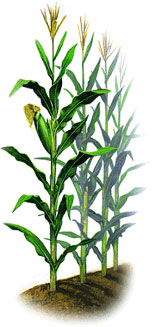
CORN
DELAYED APPLICATIONS OF PRE-EMERGENCE HERBICIDES FOR CORN
By J. D. Green
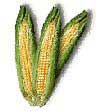 Sometimes application of a soil-active herbicide treatment
may be delayed due to weather conditions and other
factors. In these situations the crop may have emerged
before a soil residual herbicide can be applied. The
following table outlines the maximum corn and weed size
for use of soil-active herbicide products in corn. Keep in
mind that not all soil-applied herbicides can be applied
after corn emergence. In fact, some products may cause
significant crop injury if applied after crop emergence.
Many of these soil-applied herbicides do not control
emerged weeds; thus, to obtain effective weed control a
postemergence herbicide may also be needed. Consult the
product label for specific guidelines, labeled tank mixtures,
precautions, or other limitations.
Sometimes application of a soil-active herbicide treatment
may be delayed due to weather conditions and other
factors. In these situations the crop may have emerged
before a soil residual herbicide can be applied. The
following table outlines the maximum corn and weed size
for use of soil-active herbicide products in corn. Keep in
mind that not all soil-applied herbicides can be applied
after corn emergence. In fact, some products may cause
significant crop injury if applied after crop emergence.
Many of these soil-applied herbicides do not control
emerged weeds; thus, to obtain effective weed control a
postemergence herbicide may also be needed. Consult the
product label for specific guidelines, labeled tank mixtures,
precautions, or other limitations.
| Table 1. Maximum Corn and Weed Sizes for Soil-Applied Herbicides. |
|
| HERBICIDE |
CORN SIZE |
WEED SIZE |
| Atrazine |
12 inches |
1.5 inches |
| Axiom |
before corn emerges |
before emergence |
| Balance PRO |
before corn emerges |
before emergence |
| Bicep II Magnum or Cinch ATZ |
5 inches |
2-leaf stage |
| Define |
before corn emerges |
before emergence |
| Degree or Harness |
11 inches |
before emergence |
| Degree Xtra or Harness Xtra |
11 inches |
2-leaf stage |
| Dual II Magnum or Cinch |
5 inches |
before emergence |
| Epic |
before corn emerges |
before emergence |
| Expert |
12 inches |
[consult label for use on Roundup Ready corn] |
| FieldMaster |
before corn emerges |
[consult label] |
| Keystone or FulTime |
11 inches |
before emergence |
| Guardsman Max |
12 inches |
1.5 inches |
| Hornet WDG |
20 inches (V6 stage) |
4 to 8 inches |
| Lumax |
5 inches |
5 inches |
| Outlook |
12 inches |
before emergence |
| Princep |
before corn emerges |
before emergence |
| Prowl |
Spike through layby growth stage of corn or limitation of post tank mix partner |
before emergence |
| Python |
2 inches |
before emergence |
| Surpass or TopNotch |
11 inches |
before emergence |
For information about corn pests, visit
"Insect Management Recommendations".

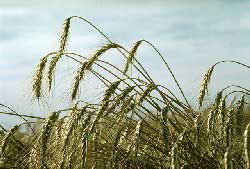
WHEAT
WHEAT DISEASE UPDATE
By Don Hershman

Barley yellow dwarf is about the only wheat disease that is
very active at the present time. Most fungal diseases, with
the exception of powdery mildew in some fields, are at
very low levels at the present time. This is probably due to
cool and/or dry conditions that have prevailed thus far
this spring. When it has rained, it has been cool and this,
too, has discouraged most fungal diseases from
developing. Late-season fungal diseases, such as leaf and
glume blotch, leaf rust (and stripe rust), and Fusarium
head blight (FHB) still have plenty of time to develop.
Thus, we are not out of the woods yet. However, the lack
of rain during the period 1-9 May, when a great many
wheat acres were in full flower, has greatly reduced the
FHB potential, in my opinion. Stripe rust has been
reported in southern Illinois, so this disease may be in the
move. Compared with leaf rust, which is visible as random
orange pustules in leaves, stripe rust (also called yellow
rust) has a linear arrangement of bright yellow-orange
pustules in leaves. This linear arrangement of pustules is
very distinctive, so stripe rust is very easy to identify.
Experience with stripe rust has shown us that it is
potentially a very destructive and fast-moving disease. To
my knowledge, we have never had a severe outbreak of
stripe rust in Kentucky. However, we are vulnerable. Most
fungicides available today will do an excellent job in
controlling rust if applied before infection takes place.
Barley yellow dwarf is fairly common throughout the state
at this time. However, there appears to be marked
difference in the severity of the disease, depending on
location. Pre-heading foliar symptom expression
(yellowing/purpling) was common in the southern tier
counties. In more northern areas, post-heading symptom
expression predominated. Early symptom expression,
which is indicative of fall or very early spring infection, is
suggestive of a significant yield loss potential. In addition
to foliar symptoms, these plants will be stunted and will
frequently have a "spiked" appearance. Yield loss in these
plants will be in the 20-40% range. Expression of foliar
symptoms after head emergence is an indication of late-
spring infection and is usually associated with minimal
yield loss.
See "Insect Management Recommendations" for more wheat pest information.

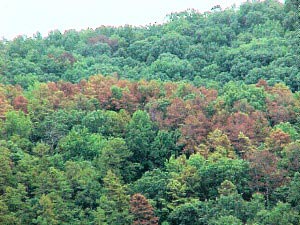
FOREST
FOREST TENT CATERPILLARS
By Lee Townsend
 The forest tent caterpillar, a close relative of the eastern
tent caterpillar, caused heavy defoliation this spring in a
Trimble county site. This "hairy" caterpillar is very similar
to the ETC but has a single row of footprint-shaped
whitish spots down the center of the back. FTC has a wider
range of favored hosts than the ETC, feeding on oaks and
many other hardwoods. When abundant, these caterpillars
will defoliate host trees and move to shrubs, fruits, and
vegetables to finish feeding. FTC does not tend to feed on
red maple, sycamore, and most conifers. Dispersal of FTC
can cover houses and mature caterpillars move from trees
to find pupation sites. There is one generation each year.
The forest tent caterpillar, a close relative of the eastern
tent caterpillar, caused heavy defoliation this spring in a
Trimble county site. This "hairy" caterpillar is very similar
to the ETC but has a single row of footprint-shaped
whitish spots down the center of the back. FTC has a wider
range of favored hosts than the ETC, feeding on oaks and
many other hardwoods. When abundant, these caterpillars
will defoliate host trees and move to shrubs, fruits, and
vegetables to finish feeding. FTC does not tend to feed on
red maple, sycamore, and most conifers. Dispersal of FTC
can cover houses and mature caterpillars move from trees
to find pupation sites. There is one generation each year.
FTC outbreaks last for about 3 seasons and then decline
but can linger for 5 to 7 years. Growth of defoliated trees
may be reduced significantly (up to 90 percent) but trees
rarely die unless other factors are acting as stressors.
FTC do not spin the tents associated with ETC. Instead.,
the group together on silken mats which they lay down on
trunks and branches. Development takes 5 to 6 weeks
ending with pupation in crevices or wrapped in folded
leaves.

PERIODICAL CICADA EMERGENCE REPORTED
By Lee Townsend
 The first report of cicada emergence in the state (May 10)
comes from Jefferson county where 4 individuals were
seen on a backyard tree. Patrick Hale (Kenton Co) has been
monitoring cicadas in Kenton and Gallatin Counties over
the past few weeks and sent this report (5/10). "Cicadas
are still about 4 inches deep in Kenton County with holes
(in dry places) coming to within 1/4 inch of the surface.
There are surface holes and mounds in wet areas. I expect
them to emerge in the next 7-10 days. Gallatin County
seems to have a heavier number of cicadas overall than
Kenton County, however I have found isolated spots
under trees and shrubs of 200 cicadas per square yard in
both Kenton and Gallatin Counties."
The first report of cicada emergence in the state (May 10)
comes from Jefferson county where 4 individuals were
seen on a backyard tree. Patrick Hale (Kenton Co) has been
monitoring cicadas in Kenton and Gallatin Counties over
the past few weeks and sent this report (5/10). "Cicadas
are still about 4 inches deep in Kenton County with holes
(in dry places) coming to within 1/4 inch of the surface.
There are surface holes and mounds in wet areas. I expect
them to emerge in the next 7-10 days. Gallatin County
seems to have a heavier number of cicadas overall than
Kenton County, however I have found isolated spots
under trees and shrubs of 200 cicadas per square yard in
both Kenton and Gallatin Counties."
Reports on periodical emergence and activity will be
available on the web through the Pest Alerts / News
feature on the Entomology Department page.
http://www.uky.edu/Agriculture/Entomology/enthp.htm
Comments, observations, or pictures for posting can be
sent to lee.townsend@uky.edu
There are many rumors and legends surrounding cicadas.
While they can be an annoyance or inconvience, cicadas
pose little concern for animals and their owners. Cicadas
are not poisonous and do not sting or bite. Consequently,
they pose no direct threat to the health and the well-being
of livestock or humans.
Dog and cats may be curious about bumbling cicadas as
they fly slowly around and blunder into objects.
Undoubtedly, pets will play with many and will consume
some. As with most food, overindulgence is the main but
unlikely downside. Some animals may be disturbed by the
buzzing flight of these insects, especially if they live near
wooded areas where cicadas are abundant. If they are near
heavily infested woods, it may be necessary to relocate
them for a time.

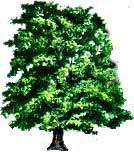
SHADE TREES AND ORNAMENTALS
SUDDEN OAK DEATH UPDATE
By John Hartman
Readers of this newsletter are no doubt aware that the
threat of the disease referred to as "sudden oak death,"
caused by the fungus-like organism Phytophthora ramorum,
is real. Although the disease can be lethal to oaks, many
other plants in the nursery trade including
rhododendrons, viburnums and camellias are carriers of
the fungus. During the past year nursery plants
inadvertently contaminated with P. ramorum were shipped
from Monrovia Nurseries, a large wholesale nursery in
California, to the states in the East. As a result, nursery
inspectors and USDA-APHIS officials in states nationwide
are gearing up to survey recipient nurseries and
surrounding areas for evidence of the pathogen. In
Kentucky, we are just beginning our survey and so far, no
P. ramorum has been found.
However, preliminary results from other states suggest
that, unless we are very lucky, we may also find this
disease here. In the East, as of last week, confirmed
positive nurseries include Florida (5), Georgia (13),
Louisiana (5), North Carolina (8), Tennessee (2), and
Virginia (1). These results are based on tracing diseased
shipments forward from Monrovia and detection of the
fungus on nursery stock in the East. Keep in mind that the
diseased shipments were made last year and therefore the
fungus has had some time to escape from or be sold from
these contaminated nurseries. Also of note, 46 nurseries
west of the Mississippi River receiving contaminated
plants from Monrovia (including 39 in California, Oregon,
and Washington) are also recorded as positives for P.
ramorum. Other states are beginning to record positive
detections from nurseries not linked to Monrovia nursery,
too.
The economic damage to the nursery industry caused by
P. ramorum is already high. Infected plants and suspects
growing nearby are destroyed in an effort to suppress
movement of the pathogen. Almost 700,000 plants worth
millions of dollars have been destroyed and over 900,000
plants are on hold, most of them at Monrovia. Federal and
state quarantines, some involving all plants coming from
California, will also have an economic impact.
For example, in Kentucky, greenhouse growers wanting
poinsettia stock plants from California have been facing
just such a quarantine. This barrier need not totally
prevent poinsettias or other plant materials from entering
Kentucky, however. Suppliers of such plant materials
need only provide the Kentucky State Entomologist with
evidence that their plants are being produced with no risk
of contamination with P. ramorum. For other kinds of
plants, where such risks exist, proof of negative tests of
plants and soil for presence of the pathogen may be
needed.
For more information on sudden oak death caused by P.
ramorum, consult the following web sites. These URL's
may take up more than one line of the newsletter column,
so they are enclosed by [brackets]. See the following:
[http://www.aphis.usda.gov/ppq/ispm/sod/] or
[
http://www.agctr.lsu.edu/eden/Issues_View.aspx?IssueID=6f50dd52-cca0-4434-8173-b6b44c18a65c] or
[http://www.suddenoakdeath.org/].


HOUSEHOLD
ELIMINATING CARPENTER ANTS
By Mike Potter
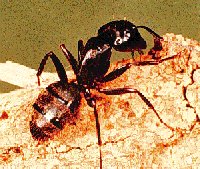 "I'm seeing big, black ants in my house, a few here and there. I
spray the ones I see, but they keep coming back. What kind of
ants are these and how do I get rid of them?" These are the
questions typically asked by clients who have carpenter
ants. This time of year, callers may also complain about a
swarm of winged carpenter ants emerging inside their
homes - a sure sign that the ants are nesting within the
structure.
"I'm seeing big, black ants in my house, a few here and there. I
spray the ones I see, but they keep coming back. What kind of
ants are these and how do I get rid of them?" These are the
questions typically asked by clients who have carpenter
ants. This time of year, callers may also complain about a
swarm of winged carpenter ants emerging inside their
homes - a sure sign that the ants are nesting within the
structure.
Description and Habits
Carpenter ants vary in size and color, but are usually
rather large (1/4-1/2") and blackish. Not every large black
ant encountered around homes is a carpenter ant, however
(see footnote* below). Besides being a nuisance, carpenter
ants may damage wood while hollowing it out for nesting.
The galleries have a smooth, sandpapered appearance and
contain no mud, which distinguishes them from wood
damaged by termites. Shredded fragments of wood similar
to coarse sawdust are ejected from the galleries, along with
dead ants and bits of insects that the carpenter ants have
eaten. When such accumulations are found, it's a good
indication that a nest is nearby. Often, however, the
excavated sawdust remains hidden behind a wall or in
some other concealed area.
Carpenter ants nest in moist or dry locations, but prefer
sites that are moist. Consequently, nests often occur in
wood dampened by water leaks, such as around sinks,
bathtubs, shower stalls, poorly sealed window and door
frames, leaking roofs, and within damp crawlspaces.
When considering likely nesting sites, it's also important to
remember that carpenter ants nest in areas other than wood.
Nests commonly occur in moist, hollow spaces, like the
wall behind a dishwasher, beneath insulation in the
crawlspace, garage, basement or attic, or in a hollow porch
column. False ceilings, hollow-core doors, curtain rods, or
even an old suitcase may serve as nesting sites for
carpenter ants.
Nests can be located indoors and/or outdoors. Ants
spotted indoors may actually be nesting outdoors in a tree
stump or landscape timber, and foraging indoors in search
of food. Noticing five or more carpenter ants per day in an
area of the home where there is no food, such as a
bathroom or bedroom, usually indicates an indoor nest.
Swarms of winged carpenter ants emerging indoors is
another sign of an indoor nest, as is the sighting of ants
indoors on cool or rainy days.
The potential for damage exists only when ants are nesting
inside the structure. In Kentucky, damage produced by
carpenter ants is often insignificant and seldom as extensive as
that associated with termites. Nonetheless, over extended
periods, large colonies can weaken studs, joists and other
structural timbers.
Control Tips
The traditional way to control carpenter ants has been to
find and treat the nest(s) directly with an insecticide dust
or spray. This is easier said than done. Carpenter ants
seldom travel in clearly defined ant "trails" as do many
other ants. When attempting to locate a nest, focus your
efforts on where most of the ants have been seen. Areas
dampened by moisture, e.g., around sinks, dishwashers,
chimneys, fascia boards, roof edge, and window or door
frames are especially attractive to carpenter ants, although
dry walls may also serve as nesting sites. The chances of
finding ants will be much greater at night since carpenter
ants do most of their foraging after dark.
The vicinity of a carpenter nest can often be located by
placing small dabs of honey, jelly, or maple syrup in the
area(s) where ants have been seen. Cleanup is aided by
placing the "bait" onto small squares of wax paper or the
back (non-sticky side) of pieces of masking tape. The best
time to check the bait spots is at night when the ants are
most active. After the ants have fed on the bait, follow
them on their journey back to their nest. Be patient -
eventually the ants will disappear behind a baseboard,
cabinet, or into some other concealed location such as
behind a wall, window, door frame or porch column.
Treat behind walls and other hidden locations where ants
are entering by puffing boric acid dust into existing
cracks, or drilling small (1/8") holes into suspected nest
areas. With a little luck, the insecticide dust will disperse
in the hidden void and contact and kill the ants. If you
suspect the nest is in a wall, drill and treat at least 3-6 feet
on either side of where ants are entering so as to maximize
the chances of contacting the nest. As is true for most ants,
carpenter ants prefer to travel along wires, pipes and
edges. It often pays to inject dust into any openings
around plumbing pipes and behind (not inside) the
junction boxes of electrical light switches and receptacles.
Never apply insecticides directly into junction boxes or spray
liquids around electrical outlets. Turn off the main circuit
breaker as an additional safety precaution.
Professional pest control firms have dusters specifically
designed for this type of treatment. Homeowners wishing
to perform treatment themselves can purchase boric acid
in a ready-to-use, squeeze-type bottles. Don't expect to see
results overnight; a week or more may be needed to
eliminate the entire nest which may contain thousands of
ants.
As noted earlier, carpenter ants seen in the home may
actually be nesting outdoors and foraging indoors for food
and water. Consequently, you may end up following the
ants out into the yard, possibly to a nest located in a
stump, fence, dead tree limb, etc. Once an outdoor nest is
discovered, treatment can be performed by spraying or
drenching with Sevin or other liquid insecticide. If
outdoor nests are suspected, inspect for ants around the
foundation and siding at night with a flashlight. Like most
ants, carpenter ants prefer to trail along edges and wires.
Pay particular attention to the bottom edge of siding, areas
around doors, windows, and where utility pipes and wires
enter the structure. The sweet bait technique can again be
used to trace these ants back to their nest.
Until recently, there were few effective carpenter ant baits
available to homeowners. One new bait that may be worth
trying is Combat® Ant Killing Gel with fipronil. The
product comes in a syringe designed to dispense small
(dime to nickel-size) dabs wherever ants are seen. If
several ants can be "enticed" to feed on the insecticide-
laced bait, there's a decent chance the colony can be
eliminated. The approach is especially worth trying if the
location of the nest cannot be found, or is inaccessible.
Calling a Professional
Eliminating carpenter ants can be very challenging and
clients may want to call a professional. Pest control
companies tackle carpenter ants in different ways. Some
try to locate the nest(s) and treat them directly. Other firms
take a less targeted approach, drilling and treating as
many potential nesting sites as possible, or spraying
around the exterior foundation of buildings. The approach
that should not be taken is simply to spray indoors, month
after month, where ants were seen. Knowledgeable
companies will spend less time spraying and more time
inspecting and asking the homeowner where they have
seen ants, whether there have been moisture leaks, etc.
The homeowner can often assist the professional in
locating nests by using the sweet bait technique discussed
earlier. Two excellent new carpenter ant products available
to professionals are Maxforce® Carpenter Ant Gel (a bait
somewhat similar to the Combat® bait mentioned earlier),
and Termidor® spray applied around the building
exterior. Either product often will control an existing
infestation.
Preventing Future Problems
- Correct roof, plumbing, and other moisture leaks that
attract carpenter ants.
- 2. Clip back tree limbs and branches touching the roof or
siding of the house. These serve as "bridges" between
ants nesting in dead portions of trees and the structure.
- Seal cracks and openings in the foundation, especially
where utility pipes and wires enter from outside.
- Never store firewood in the garage since firewood is a
prime nesting location for carpenter ants. Stack wood
away from the foundation and elevate it off the ground.
* Another large black Kentucky ant often mistaken for
carpenter ants is the black field ant. Many costly
"carpenter ant" jobs are inadvertently sold to homeowners
by companies that confuse these two 'look-alike' pests. A
good hand lens is needed to tell the difference: viewed
from the side, carpenter ants have an evenly rounded
thorax (the body segment just after the head); black field
ants have a thorax which in profile appears ridged or
uneven. Black field ants commonly form large, low-profile,
earthen mounds in the yard. Unlike carpenter ants, they
do not nest within buildings although they may wander
indoors in search of food. The solution to black field ants is
simply to drench the mound with an insecticide.

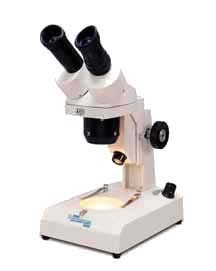
DIAGNOSTIC LAB HIGHLIGHTS
DIAGNOSTIC LAB - HIGHLIGHTS
By Julie Beale and Paul Bachi
Recent samples diagnosed have included Aphanomyces
root rot on alfalfa; barley yellow dwarf virus, bacterial
streak, and loose smut on wheat; Sclerotinia collar rot,
damping off (Rhizoctonia), Pythium root rot, and target
spot on tobacco.
On fruits, we have seen orange rust on blackberry;
Mycosphaerella leaf spot on strawberry; and leaf curl on
peach.
On ornamentals, we have seen Botrytis blight on vinca;
needle rust on pine; symptoms of ozone injury (from last
fall) on white pine; and needle miner and spider mite on
spruce.

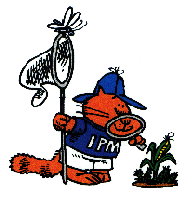
IPM TRAP COUNTS:
By Patty Lucas, University of Kentucky Research Center
UKREC-Princeton, KY, April 30 - May 7, 2004
| Black Cutworm
| 10
|
| True Armyworm
| 11
|
| Corn Earworm
| 5
|
| European Corn Borer
| 1
|
|
For information on trap counts in southern Illinois visit the
Hines Report at -
http://www.ipm.uiuc.edu/pubs/hines_report/index.html.
The Hines Report is posted weekly by Ron Hines, Senior
Research Specialist, at the University of Illinois Dixon
Springs Agricultural Center
NOTE: Trade names are used to simplify the information presented in
this newsletter. No endorsement by the Cooperative Extension Service
is intended, nor is criticism implied of similar products that are not
named.
Lee Townsend
Extension Entomologist
BACK
TO KY PEST NEWS HOME
 Bacterial soft rot and blackleg are active in some
greenhouses transplant production systems. A slimy to
jelly-like soft rot (accompanied with strong odors) was
common on the base of stems, but in some cases was
advancing up one side of the stem after going systemic in
what is the blackleg phase of the disease. With the warmer
outside temperatures, activity is also likely in outdoor float
systems too, but it is not likely in outdoor ground beds
until later when more growth and canopy closure have
developed. In ground beds these soft rots occur mainly in
the transplants during wet periods when the plants are
about ready to be set and growers cannot get them into the
field.
Bacterial soft rot and blackleg are active in some
greenhouses transplant production systems. A slimy to
jelly-like soft rot (accompanied with strong odors) was
common on the base of stems, but in some cases was
advancing up one side of the stem after going systemic in
what is the blackleg phase of the disease. With the warmer
outside temperatures, activity is also likely in outdoor float
systems too, but it is not likely in outdoor ground beds
until later when more growth and canopy closure have
developed. In ground beds these soft rots occur mainly in
the transplants during wet periods when the plants are
about ready to be set and growers cannot get them into the
field.



 Sometimes application of a soil-active herbicide treatment
may be delayed due to weather conditions and other
factors. In these situations the crop may have emerged
before a soil residual herbicide can be applied. The
following table outlines the maximum corn and weed size
for use of soil-active herbicide products in corn. Keep in
mind that not all soil-applied herbicides can be applied
after corn emergence. In fact, some products may cause
significant crop injury if applied after crop emergence.
Many of these soil-applied herbicides do not control
emerged weeds; thus, to obtain effective weed control a
postemergence herbicide may also be needed. Consult the
product label for specific guidelines, labeled tank mixtures,
precautions, or other limitations.
Sometimes application of a soil-active herbicide treatment
may be delayed due to weather conditions and other
factors. In these situations the crop may have emerged
before a soil residual herbicide can be applied. The
following table outlines the maximum corn and weed size
for use of soil-active herbicide products in corn. Keep in
mind that not all soil-applied herbicides can be applied
after corn emergence. In fact, some products may cause
significant crop injury if applied after crop emergence.
Many of these soil-applied herbicides do not control
emerged weeds; thus, to obtain effective weed control a
postemergence herbicide may also be needed. Consult the
product label for specific guidelines, labeled tank mixtures,
precautions, or other limitations.



 The forest tent caterpillar, a close relative of the eastern
tent caterpillar, caused heavy defoliation this spring in a
Trimble county site. This "hairy" caterpillar is very similar
to the ETC but has a single row of footprint-shaped
whitish spots down the center of the back. FTC has a wider
range of favored hosts than the ETC, feeding on oaks and
many other hardwoods. When abundant, these caterpillars
will defoliate host trees and move to shrubs, fruits, and
vegetables to finish feeding. FTC does not tend to feed on
red maple, sycamore, and most conifers. Dispersal of FTC
can cover houses and mature caterpillars move from trees
to find pupation sites. There is one generation each year.
The forest tent caterpillar, a close relative of the eastern
tent caterpillar, caused heavy defoliation this spring in a
Trimble county site. This "hairy" caterpillar is very similar
to the ETC but has a single row of footprint-shaped
whitish spots down the center of the back. FTC has a wider
range of favored hosts than the ETC, feeding on oaks and
many other hardwoods. When abundant, these caterpillars
will defoliate host trees and move to shrubs, fruits, and
vegetables to finish feeding. FTC does not tend to feed on
red maple, sycamore, and most conifers. Dispersal of FTC
can cover houses and mature caterpillars move from trees
to find pupation sites. There is one generation each year.
 The first report of cicada emergence in the state (May 10)
comes from Jefferson county where 4 individuals were
seen on a backyard tree. Patrick Hale (Kenton Co) has been
monitoring cicadas in Kenton and Gallatin Counties over
the past few weeks and sent this report (5/10). "Cicadas
are still about 4 inches deep in Kenton County with holes
(in dry places) coming to within 1/4 inch of the surface.
There are surface holes and mounds in wet areas. I expect
them to emerge in the next 7-10 days. Gallatin County
seems to have a heavier number of cicadas overall than
Kenton County, however I have found isolated spots
under trees and shrubs of 200 cicadas per square yard in
both Kenton and Gallatin Counties."
The first report of cicada emergence in the state (May 10)
comes from Jefferson county where 4 individuals were
seen on a backyard tree. Patrick Hale (Kenton Co) has been
monitoring cicadas in Kenton and Gallatin Counties over
the past few weeks and sent this report (5/10). "Cicadas
are still about 4 inches deep in Kenton County with holes
(in dry places) coming to within 1/4 inch of the surface.
There are surface holes and mounds in wet areas. I expect
them to emerge in the next 7-10 days. Gallatin County
seems to have a heavier number of cicadas overall than
Kenton County, however I have found isolated spots
under trees and shrubs of 200 cicadas per square yard in
both Kenton and Gallatin Counties."


 "I'm seeing big, black ants in my house, a few here and there. I
spray the ones I see, but they keep coming back. What kind of
ants are these and how do I get rid of them?" These are the
questions typically asked by clients who have carpenter
ants. This time of year, callers may also complain about a
swarm of winged carpenter ants emerging inside their
homes - a sure sign that the ants are nesting within the
structure.
"I'm seeing big, black ants in my house, a few here and there. I
spray the ones I see, but they keep coming back. What kind of
ants are these and how do I get rid of them?" These are the
questions typically asked by clients who have carpenter
ants. This time of year, callers may also complain about a
swarm of winged carpenter ants emerging inside their
homes - a sure sign that the ants are nesting within the
structure.

